Therapeutic Potential of Marine Probiotics: A Survey on the Anticancer and Antibacterial Effects of Pseudoalteromonas spp.
Abstract
:1. Introduction
| S/N | Therapy | Side Effects | Therapy Cost | Production Cost | Drug Resistance | Bioaccumulation | Mutation | Injury | Reference |
|---|---|---|---|---|---|---|---|---|---|
| 1 | Chemotherapeutic drugs | Extensive side effects | High cost of acquiring and maintaining therapy | High cost of development and production of candidate drugs | Contribution of chemicals to increasing drug resistance | Bioaccumulation of chemicals | Not applicable | Not applicable | [19] |
| 2 | Radiation | Extensive side effects | High cost of acquiring and maintaining therapy | Not applicable | Not Applicable | Bioaccumulation of radiation | Induction of mutation | Inadequate replacement of damaged stem cells | [13] |
| 3 | Natural products | Minimal side effects | Relatively low cost of acquiring and maintaining therapy | Relatively low cost of isolation, identification, characterization, and production | Little or no contribution to resistance | Little or no accumulation | No induction of mutation | No injuries | [20] |
2. Methodology
3. Probiotics, Sources, and Classifications
4. Marine Probiotics and General Therapeutic Potentials
| Bioactivity | Drugs | Microbial Source | Reference |
|---|---|---|---|
| Anticancer | Actinomycin, Salinosporamide A (Marizomib®) (NPI-0052), Plinabulin, Enzastaurin, Lestaurtinib, Becatecarin, GSK2857916, Ladiratuzumab vedotin, Tisotumab vedotin, Glembatumumab vedotin, Denintuzumab mafodotin, Midostaurin (Rydapt®), Pinatuzumab vedotin, ASG-15ME, Lifastuzumab vedotin, Vandortuzumab vedotin, UCN-01 | Streptomyces sp., Salinospora tropica, Aspergillus sp., Streptomyces staurosporeus, Saccharothrix aerocolonigenes, Caldora penicillata | [75,76] |
| Antimicrobial | Gageotetrins A–C, Gageopeptides A–D, Ieodoglucomide 1, 2, Marinopyrrole A, Merochlorin A, Anthracimycin | Bacillus subtillis 109GGC020, Bacillus licheniformis 09IDYM23, Streptomyces sp. | [77,78] |
| Immunomodulatory | Brentuximab vedotin, Polatuzumab vedotin (DCDS-4501A), Belantamab madofotin-blmf | Symploca sp. VP642, Cyanobacteria | [79] |
| Antioxidant | Hexaricins F, Asperchalasine I | Streptosporangium sp. CGMCC 4.7309, Mycosphaerella sp. SYSU-DZG0 | [80] |
| Antiinflammatory | Cyclic peptide cyclomarin, Violaceomide A, Dehydrocurvularin | Streptomyces sp., Aspergillus terreus H010, Penicillium sumatrense | [78,80] |
5. Pseudoalteromonas spp.; Therapeutic Potentials and Systematic Survey
| Category | Pseudoalteromonas sp. | Study | Method | Active Agent | Structure | Mechanism of Action | References |
|---|---|---|---|---|---|---|---|
| Proteins/enzymes | Pseudoalteromonas sp. Xi13, (genomically associated with P. carrageenovora IAM 12662 and Pseudoalteromonas sp. An99) | Comparison of immobilized and lyophilized k-Selenocarrageenase produced from Pseudoalteromonas sp. Xi13 and The complete genome sequencing of Pseudoalteromonas sp. Xi13 and anticancer effects of the selenium oligosaccharides. | Response Surface Methodology, 16S rRNA gene sequencing, and Cell mass detection of cancer cells | k-Selenocarrageenase |  | k-Selenocarrageenase acts by degrading k-Selenocarrageenan to selenium oligosaccharides, possibly involving complex glycoside hydrolase | [88,89] |
| P. tetradonis, P. porphyrae LL1, Pseudoalteromonas sp. ZDY3 | Catalytic activity and thermostability enhancement of two similar mutants k-Carrageenases. The expression of the same enzyme from P. porphyrae LL1 in B. choshinensis | PoPMuSiC algorithm. Cloning, transformation, and enzyme activity assays. Enzyme isolation, purification, LC-HRMS | k-Carrageenases. |  | Produces even numbered k-Carrageenan oligosaccharides by catalyzing k-Carrageenans | [90,91,92] | |
| P. carrageenovora | Characterization (pH and temperature) of arylsulfatase from P. carrageenovora mutants | Library construction, sequencing, expression, purification, and determination of arylsulfatase activity following pH and temperature variations. | Arylsulfatase | 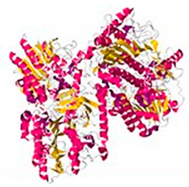 | The use in the detection of cancer cells was not stated. However, arylsulfatase enables the arylsulfatase hydrolysis into inorganic sulfate and aryl compounds. | [93] | |
| Pseudoalteromonas sp. strain 1020R | Determined the effects of prodigiosins produced by Pseudoalteromonas sp. strain 1020R on the protein kinases and phosphate as targets in the cell death of cancer cells through apoptosis using leukemia cell lines. | Cytotoxicity, protein phosphatase, and kinase assay | Prodigiosins (2-methyl-3-pentylprodiginine, 2-methyl-3-heptylprodiginine, 2-methyl-3-butylprodiginine, and 2-methyl-3-hexylprodiginine) |  | Protein-phosphatase inhibited cytotoxicity of the leukemia cancer cells. Also, that mechanism activation is independent of the p53 protein. | [94] | |
| Polymer, polysaccharides, and peptides | P. nigrifaciens Sq02-RifT | Assay of the antitumor effect on colon cancer cells by capsular polysaccharide isolated from P. nigrifaciens Sq02-RifT | Chemical and spectroscopic methods, Cell viability assay | Capsular polysaccharide | 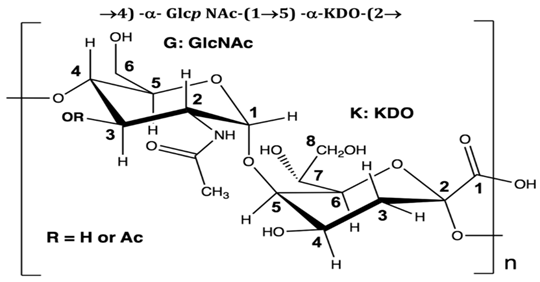 | Activate Caspases -3 and -9 on the CaCo-2 and HCT-116 of the cancer cells inducing apoptosis. | [95] |
| P. piscicida SWA4_PA4. | Iron chelating activity and cytotoxicity effects (against human T lymphocyte cells) of novel Pseudoalteropeptide A (lipopeptide) isolated from P. piscicida SWA4_PA4. | Peptide isolation, spectroscopy, and viability assay | Pseudoalteropeptide A | 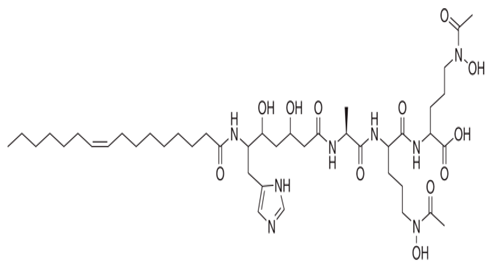 | Iron chelating activity and cytotoxicity effects | [96] | |
| Extracts and organic compounds | P. haloplanktis TAC125 | The antiproliferative effects of ethyl acetate crude extract and compounds of marine P. haloplanktis TAC125 against A549 lung epithelial cancer cells | 3-(4,5-Dimethylthiazol-2-yl)-2,5-Diphenyltetrazolium Bromide (MTT) viability assay, bioassay-guided purification, and mass spectrometry | 4-hydroxybenzoic acid |  | Activates specific well-regulated molecular pathways, Pyroptotic cell death signaling, which triggers the transcription of Caspase -1 and subsequent proinflammatory cytokines | [97] |
| Nanoparticles | P. shioyasakiensis | Reduction and cytotoxicity effects of P. shioyasakiensis-based nanoparticles. | Estimation of cell viabilities. | Selenium and tellurium nanoparticles of P. shioyasakiensis | - | Different pathways and enzymes, including reductases, siderophores, glutaredoxin, and glutathione, in converting selenium and tellurium to their nanoparticles; however, the specific mechanisms used by the isolates were not covered. | [83] |
5.1. Marine Probiotic Pseudoalteromonas spp. in the Prevention/Management of Cancer
5.1.1. Anticancer Pseudoalteromonas spp. Proteins/Enzymes
5.1.2. Anticancer Pseudoalteromonas spp. Polymer, Polysaccharides, and Peptides
5.1.3. Anticancer Pseudoalteromonas spp. Extracts and Organic Compounds
| Category | Pseudoalteromonas sp. | Study | Method | Active Agent | Structure | Mechanism of Action | Reference |
|---|---|---|---|---|---|---|---|
| Genes and proteins/enzymes | Pseudoalteromonas sp. 1400 | P. aeruginosa-implicated biofilm inhibition by alginolytic enzymes produced by thirty-six bacterial isolates, including Pseudoalteromonas sp. 1400 | Enzyme isolation, activity, antibiofilm assays, immunofluorescent staining, and chromatography | Alginate lyase (AlyP1400) |  | Dual lyase activity of degrading poly-glucuronic and -mannuronic acids. Hydrolytic and disruptive effects of the enzyme against the extracellular alginate produced by P. aeruginosa CF27 | [98,99] |
| P. luteoviolacea S4054 | Assay of the bioactive violacein and indolmycin produced by a mutant P. luteoviolacea S4054 | Antibacterial/diffusion, UHPLC-UV/Vis studies | Violacein, indolmycin |  | Not available | [100] | |
| P. phenolica KCTC 12086T | The complete genome elucidation of P. phenolica KCTC 12086T, which could produce antibiotic compounds | Genome sequencing techniques | Polybrominated compounds: polybrominated-diphenyl ethers, -bipyrroles, and -biphenyls |  | Not available | [101] | |
| P. xiamenensis STKMTI.2 | The complete genome elucidation of P. xiamenensis STKMTI.2 | Genome sequencing techniques | Brominated marine phenols/pyrroles and secondary metabolites (peptides, butyrolactone, prodigiosin, RiPP-like, and Lant I) | 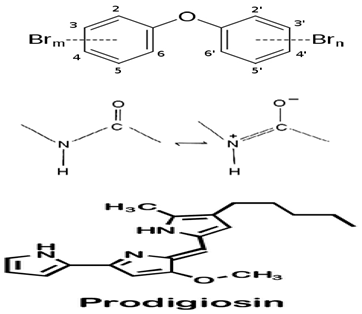 | Not available | [102] | |
| Pseudoalteromonas sp. NC201 | The complete genome elucidation of Pseudoalteromonas sp. NC201 | Genome sequencing techniques | Peptides (bacteriocins and gramicidin/tyrocidine) |  | Not available | [103,104] | |
| P. tunicate | Studied and sequenced the tam operon, which initiates the synthesis of P. tunicate-produced tambjamine YP1, a natural bipyrrole antibiotic | Genome sequencing techniques, mass spectrometry analysis | Tambjamine YP1 |  | Not available | [105] | |
| P. luteoviolacea | Analyzed different geographic sort isolates of P. luteoviolacea for biosynthetic richness and diversity | Metabolomic, Genome sequencing techniques, mass spectrometry analysis | Indolmycin |  | Not available | [106] | |
| P. rubra | Genomic study of P. rubra gene responsible for cycloprodiginine production. | Genome sequencing techniques | Cyclo-prodiginine |  | Not available | [107] | |
| P. flavipulchra JG1 | Genome sequence of P. flavipulchra JG1 responsible for producing P. flavipulchra antibacterial Protein (PfaP) for specific genes or clusters responsible for the expression of the antibacterial protein, proven to have inhibitory effects against certain bacteria. | Genome sequencing techniques | P. flavipulchra antibacterial Protein (PfaP) | - | P. flavipulchra antibacterial Protein (PfaP) oxidatively deaminates certain amino acids to α-keto acids, hydrogen peroxide, and ammonium. Hydrogen peroxide decomposes into other metabolites, which exhibit antimicrobial effects. | [108] | |
| P. piscicida | Genome sequencing of P. piscicida 36Y_RITHPW produces bioactive compounds with inhibition effects against multi-resistant V. parahaemolyticus implicated in Shrimp hepatopancreatic necrosis disease. | Genome sequencing techniques | Bacteriocins, peptides |  | Not available | [109] | |
| P. piscicida strain DE2-B | Genome sequence of P. piscicida strain DE2-B | Genome sequencing techniques | Proteolytic enzymes, peptides, polyketides, and alkaloids | 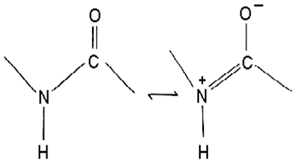 | Not availables | [110] | |
| Pseudalteromonas sp. 3J6 | Sequence elucidation and antibiofilm effect of Pseudalteromonas sp. 3J6 | Genome sequencing techniques, Antibiofilm assay | Alterocin | 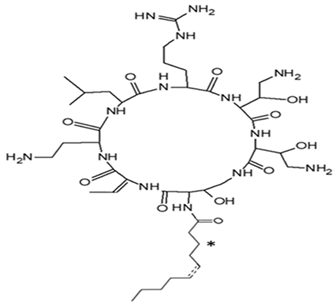 | Not available | [111] | |
| Polymer, Polysaccharides, and peptides | P. prydzensis/mariniglutinosa, P. paragorgicola/elyakovii | Isolation, identification of peptides and bacteria of Oysters hemolymph and their antibacterial effects. | Antimicrobial activities | Peptides |  | Not available | [112] |
| Pseudoalteromonas spp (Designgated hCg-6, hCg-42, hOe-66, hOe-124, and hOe-125) | Alterins isolated using the bacterial cell-free culture were subjected to antibacterial assays against some gram-negative bacteria. Mechanism of alterin activity determined via lipopolysaccharide binding assays | Minimal Inhibitory Concentration (MIC), UPLC-HRMS | Alterins |  | Provide the depolarization of the bacterial membrane and the subsequent cell permeabilization and lysis. | [113,114] | |
| P. shioyasakiensis and P. mariniglutinosa. | Poly-hydroxybutyrate-co hydroxy-hexanoate (PHBH) degrading abilities of certain gram-negative bacteria, including P. shioyasakiensis and P. mariniglutinosa. | Bacterial isolation, degradation, and isolation of monomers, antibacterial assay | 3-hydroxy-butyrate, 3-hydroxy-hexanoate, hydroxy-alkanoic acids |  | Degradation of Poly-hydroxybutyrate-co hydroxy-hexanoate (PHBH) to antibacterial monomers | [115] | |
| Pseudoalteromonas sp. SANK 71903 | Tested an array of secondary metabolites of Pseudoalteromonas sp. SANK 71903 for potential inhibition effects against lipopolysaccharide (LPS) | LPS, inhibition assay, MIC | Cyclic Peptides, Ogipeptins (A–D) |  | LPS inhibition by CD14 binding and cytokine secretion blockage from LPS-stimulated cells. | [116] | |
| Extracts and organic compounds | P. ruthenica S6031. | In-vitro and vivo studies by Wasana et al. [117] demonstrated the probiotic potentials of P. ruthenica S6031, especially against E. piscicida. | Agar spot, In vivo studies | P. ruthenica S6031 supplements | - | Not available | [117] |
| Pseudoalteromonas sp. J010 | Determination of the antibacterial effect of korormicin against Vibrio sp. | MIC, sequence data studies | Korormicin |  | Korormicin releases reactive O2 species via the electron transfer initiation in the enzyme, which promotes O2 and some redox cofactors reactions. | [118] | |
| Pseudoalteromonas spp. coded CDM8 and CDA22. | In vitro antibacterial activity and in vivo probiotic potential against V. parahaemolyticus, and PCR evaluations of two Pseudoaltermonas spp. | In vitro, in vivo, PCR evaluations | Pseudoalteromonas spp. coded CDM8 and CDA22 | - | Reduction of the copy number of V. parahaemolyticus toxin production gene, PirAvp | [119] | |
| P. flavipulchra CDM8 | Described the antibacterial mechanisms of P. flavipulchra CDM8 with potent inhibition activities against Bacillus spp. and Vibrio spp. | Antimicrobial biofilm assays and microscopy | Hydrogen peroxide, PfaP-like antibacterial proteins, and other molecules, surface positioned vesicle/pilus-like structure | 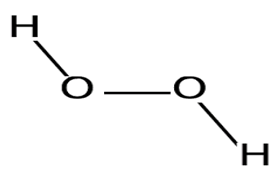 | The transferable outer surface positioned vesicle/pilus-like structure likely contributes to the inhibition activities observed and is described as a novel mechanism of antibacterial activity by the isolate. | [120] | |
| Pseudoalteromonas sp. type strain S4498 | Identification and determination of the mechanisms of secondary metabolites of Pseudoalteromonas sp. type strain S4498 | Use of antiSMASH and bioassays | Tetrabromopyrrole |  | Tetrabromopyrrole induces its antimicrobial effects through its signaling properties, induction of cellular stress, and the activities of dibromo-maleimide, its oxidized by-product. | [121] | |
| Pseudoalteromonas sp. (designated as hCg-51) | Assay of the different cell-free cultures of 843 species/strains obtained within the haemolymphs microbiota of bivalve species from the sea | Well diffusion and hemolymph-associated strain assays | Pseudoalteromonas sp. (designated as hCg-51) | - | Not available | [122] | |
| Pseudolateromonas spp., Pseudolateromonas sp. (hCg-6) | Assay of a collection of 11 Pseudolateromonas spp. obtained from the hemolymph of mussels and oysters for their antibacterial activities against V. harveyi. | Well diffusion, PCR, and hemolymph-associated strain assays | Pseudolateromonas spp., Pseudolateromonas sp. (hCg-6) | - | Not available | [123] | |
| P. issachenkonii, P. haloplanktis TAC125 | Antibacterial activities against E. coli, S. epidermis, and K. rhizophila by solvents extracts two Pseudoalteromonas spp., among other marine bacteria isolated from the surface of various marine macroalgae. | Well diffusion assay and phylogenetics | P. issachenkonii, P. haloplanktis TAC125 | - | Not available | [124] | |
| P. haloplanktis TAC125 | Antibiofilm activity of the culture supernatant of P. haloplanktis TAC125 against S. epidermidis | Antibiofilm assay | P. haloplanktis TAC125 | - | Disruption of the S. epidermidis biofilm multicellular structure. | [125] | |
| P. haloplanktis TAC125 | Culture, fermentation, and antibacterial activity of methylamine from P. haloplanktis TAC125 | Fermentation, minimum volatile inhibitory concentrations | Methylamine | 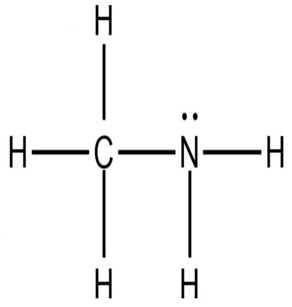 | Sannino et al., via a defined culture and fermentation system, produced and accumulated methylamine, a volatile organic compound (VOC), from P. haloplanktis TAC125, which by the minimum volatile inhibitory concentrations, presented a dose-dependent inhibition of different strains of Burkholderia spp. and E. coli. | [126] | |
| P. haloplanktis | Assay of the antibacterial properties of pentadecanol, a metabolite of P. haloplanktis, and the derivatives against Listeria monocytogenes | Minimum inhibitory concentrations. | Pentadecanol |  | Not available | [127] | |
| P. haloplanktis TAC125 | Antibiofilm activity against S. epidermis O-47, S. epidermidis RP62A | Antibiofilm assay | Pentadecanol | 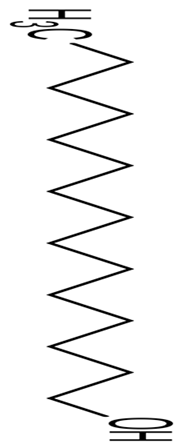 | The interference of the quorum sensing system of the S. epidermis by the AI-2 signaling process. | [128] | |
| P. rubra TKJD 22 | Isolation of organic compounds from Tunicate-associated bacteria and antibacterial activities of compounds. | Sequencing, NMR, Minimum inhibitory concentration | Isatin |  | Not available | [129] | |
| Pseudoalteromonas strain J010 | Isolation of bioactive compounds from the ethanol extract of Pseudoalteromonas strain J010 and determination of their antimicrobial activities. | Disc-diffusion assay, MS, and NMR techniques. | 4′-(3,4,5-tribromo-1 H-pyrrol-2-yl) methyl) phenol (a bromopyrrole), 5 koromicins, and tetrabromopyrrole |  | Not available | [130] | |
| P. piscicida S2040 | Isolation of bioactive compounds from the extracts of P. piscicida S2040 and determination of their antimicrobial activities. | Disc-diffusion assay, MS, and NMR techniques. | Bromo- and dibromoalterochromides, myxochelins A and B, and alteramide A | 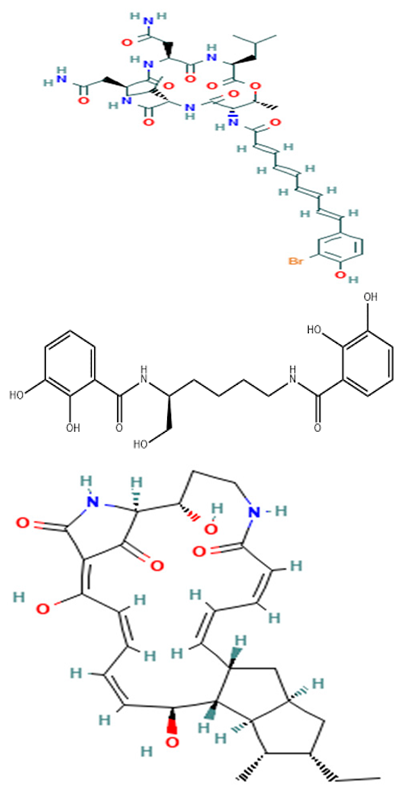 | Not available | [131] | |
| P. piscicida 2202 | Antibacterial activity of P. piscicida 2202 isolated from Modiolus kurillenis | Antimicrobial activity | P. piscicida 2202 | - | Not available | [132] | |
| Pseudoalteromonas sp. JS19 MT102924.1 | Extraction, phytochemical assay, and antibacterial effect of Pseudoalteromonas sp. JS19 MT102924.1 | Antimicrobial activity, FTIR | Pseudoalteromonas sp. JS19 MT102924.1 | - | Not available | [133] | |
| Nanoparticles | P. shioyasakiensis | Antimicrobial effects of P. shioyasakiensis-based nanoparticles | Inhibitory zones and minimum inhibitory concentrations | Selenium and tellurium nanoparticles of P. shioyasakiensis | - | The study suggests the contribution of different pathways and different enzymes, including reductases, siderophores, glutaredoxin, and glutathione, in the conversion of selenium and tellurium to their nanoparticles; however, the particular mechanisms used by the isolates were not covered. | [83] |
5.1.4. Anticancer Pseudoalteromonas Nanoparticles
5.2. Antibacterial Activities of Pseudoalteromonas spp.
5.2.1. Antibacterial Pseudoalteromonas spp. Genes and Proteins/Enzymes
5.2.2. Antibacterial Pseudoalteromonas spp. Polymer, Polysaccharides, and Peptides
5.2.3. Antibacterial Pseudoalteromonas spp. Extracts and Organic Compounds
5.2.4. Antibacterial Pseudoalteromonas spp. Nanoparticles
6. Discussion
7. Production and Development of Marine Probiotics
8. Limitations, Prospects, Future Perspectives
9. Conclusions
Author Contributions
Funding
Institutional Review Board Statement
Informed Consent Statement
Data Availability Statement
Conflicts of Interest
References
- Atanasov, A.G.; Zotchev, S.B.; Dirsch, V.M.; Supuran, C.T. Natural products in drug discovery: Advances and opportunities. Nat. Rev. Drug. Discov. 2021, 20, 200–216. [Google Scholar] [CrossRef] [PubMed]
- Calixto, J.B. The role of natural products in modern drug discovery. An. Acad. Bras. Ciênc. 2019, 91 (Suppl. S3), e20190105. [Google Scholar] [CrossRef] [PubMed]
- Newman, D.J.; Cragg, G.M. Natural products as sources of new drugs over the nearly four decades from 01/1981 to 09/2019. J. Nat. Prod. 2020, 83, 770–803. [Google Scholar] [CrossRef] [Green Version]
- Code of Practice for Fish and Fishery Products. FAO and WHO; 2020. Available online: http://www.fao.org/documents/card/en/c/cb0658en (accessed on 20 March 2023).
- Chen, Z.; Guo, J.; Jiang, Y.; Shao, Y. High concentration and high dose of disinfectants and antibiotics used during the COVID-19 pandemic threaten human health. Environ. Sci. Eur. 2021, 33, 11. [Google Scholar] [CrossRef]
- Okocha, R.C.; Olatoye, I.O.; Adedeji, O.B. Food safety impacts of antimicrobial use and their residues in aquaculture. Public Health Rev. 2018, 39, 21. [Google Scholar] [CrossRef] [Green Version]
- The Rules Governing Medicinal Products in the European Union. In GMP/ISO Quality Audit Manual for Healthcare Manufacturers and Their Suppliers, (Volume 2—Regulations, Standards, and Guidelines), 6th ed.; CRC Press: Boca Raton, FL, USA, 2004; pp. 257–316. Available online: https://www.taylorfrancis.com/books/9780203026656/chapters/10.3109/9780203026656-14 (accessed on 20 March 2023).
- Tripathy, A.; Dash, J.; Kancharla, S.; Kolli, P.; Mahajan, D.; Senapati, S.; Jena, M.K. Probiotics: A promising candidate for management of colorectal cancer. Cancers 2021, 13, 3178. [Google Scholar] [CrossRef]
- Sung, H.; Ferlay, J.; Siegel, R.L.; Laversanne, M.; Soerjomataram, I.; Jemal, A.; Bray, F. Global Cancer Statistics 2020: GLOBOCAN estimates of incidence and mortality worldwide for 36 cancers in 185 countries. CA Cancer J. Clin. 2021, 71, 209–249. [Google Scholar] [CrossRef] [PubMed]
- Bedada, T.L.; Feto, T.K.; Awoke, K.S.; Garedew, A.D.; Yifat, F.T.; Birri, D.J. Probiotics for cancer alternative prevention and treatment. Biomed Pharmacother. 2020, 129, 110409. [Google Scholar] [CrossRef]
- Janelsins, M.C.; Kesler, S.R.; Ahles, T.A.; Morrow, G.R. Prevalence, mechanisms, and management of cancer-related cognitive impairment. Int. Rev. Psychiatry 2014, 26, 102–113. [Google Scholar] [CrossRef] [Green Version]
- Sultana, A.; Smith, C.T.; Cunningham, D.; Starling, N.; Neoptolemos, J.P.; Ghaneh, P. Meta-analyses of chemotherapy for locally advanced and metastatic pancreatic cancer. J. Clin. Oncol. 2007, 25, 2607–2615. [Google Scholar] [CrossRef]
- Majeed, H.; Gupta, V. Adverse Effects of Radiation Therapy. In StatPearls; StatPearls Publishing: Treasure Island, FL, USA, 2022. Available online: http://www.ncbi.nlm.nih.gov/books/NBK563259/ (accessed on 4 March 2023).
- Tarnecki, A.M.; Wafapoor, M.; Phillips, R.N.; Rhody, N.R. Benefits of a Bacillus probiotic to larval fish survival and transport stress resistance. Sci. Rep. 2019, 9, 4892. [Google Scholar] [CrossRef] [PubMed] [Green Version]
- Martínez, C.P.; Ibáñez, A.L.; Monroy, H.O.A.; Ramírez, S.H.C. Use of probiotics in aquaculture. ISRN Microbiol. 2012, 2012, 916845. [Google Scholar] [CrossRef] [PubMed] [Green Version]
- Borchert, E.; Knobloch, S.; Dwyer, E.; Flynn, S.; Jackson, S.A.; Jóhannsson, R.; Marteinsson, V.T.; O’Gara, F.; Dobson, A.D.W. Biotechnological Potential of Cold Adapted Pseudoalteromonas spp. Isolated from ‘Deep Sea’ Sponges. Mar. Drugs 2017, 15. Available online: https://www.ncbi.nlm.nih.gov/pmc/articles/PMC5484134/ (accessed on 13 May 2023).
- Paulsen, S.S.; Strube, M.L.; Bech, P.K.; Gram, L.; Sonnenschein, E.C. Marine chitinolytic Pseudoalteromonas represents an untapped reservoir of bioactive potential. mSystem 2019, 4, e00060-19. [Google Scholar] [CrossRef] [PubMed] [Green Version]
- Offret, C.; Desriac, F.; Le Chevalier, P.; Mounier, J.; Jégou, C.; Fleury, Y. Spotlight on antimicrobial metabolites from the marine bacteria Pseudoalteromonas: Chemodiversity and ecological significance. Mar. Drugs 2016, 14, 129. [Google Scholar] [CrossRef] [Green Version]
- Leighl, N.B.; Nirmalakumar, S.; Ezeife, D.A.; Gyawali, B. An arm and a leg: The rising cost of cancer drugs and impact on access. Am. Soc. Clin. Oncol. Educ. Book. 2021, 41, e1–e12. [Google Scholar] [CrossRef]
- Dzobo, K. The role of natural products as sources of therapeutic agents for innovative drug discovery. Compr. Pharmacol. 2022, 408–422. [Google Scholar]
- Sayes, C.; Leyton, Y.; Riquelme, C. Probiotic bacteria as an healthy alternative for fish aquaculture. Antibiot. Use Anim. Savic. Ed. Rij. Croat. InTech. Publ. 2018, 115–132. [Google Scholar]
- Blackall, L.L.; Dungan, A.M.; Hartman, L.M.; van Oppen, M.J. Probiotics for corals. Microbiol. Aust. 2020, 41, 100–104. [Google Scholar] [CrossRef]
- El-Saadony, M.T.; Swelum, A.A.; Abo Ghanima, M.M.; Shukry, M.; Omar, A.A.; Taha, A.E.; Salem, H.M.; El-Tahan, A.M.; El-Tarabily, K.A.; El-Hack, E.A. Shrimp production, the most important diseases that threaten it, and the role of probiotics in confronting these diseases: A review. Res. Vet. Sci. 2022, 144, 126–140. [Google Scholar] [CrossRef]
- Saraf, K.; Shashikanth, M.C.; Priy, T.; Chaitanya, N.C. Probiotics-do they have a role in medicine and dentistry. J. Assoc. Physicia. Ind. 2010, 58, 488–490. [Google Scholar]
- Binda, S.; Hill, C.; Johansen, E.; Obis, D.; Pot, B.; Sanders, M.E.; Tremblay, A.; Ouwehand, A.C. Criteria to qualify mas “Probiotic” in foods and dietary supplements. Front. Microbiol. 2020, 11, 1662. [Google Scholar] [CrossRef] [PubMed]
- Sen, M. Role of probiotics in health and disease—A review. Int. J. Adv. Life. Sci. Res. 2019, 30, 1–11. [Google Scholar]
- Mujeeb, I.; Ali, S.H.; Qambarani, M.; Ali, S.A. Marine bacteria as potential probiotics in aquaculture. J. Microbiol. Biotechnol. Food Sci. 2022, e5631. [Google Scholar] [CrossRef]
- Vázquez, J.A.; Durán, A.; Nogueira, M.; Menduíña, A.; Antunes, J.; Freitas, A.C.; Gomes, A.M. Production of marine probiotic bacteria in a cost-effective marine media based on peptones obtained from discarded fish by-products. Microorganism 2020, 8, 1121. [Google Scholar] [CrossRef] [PubMed]
- Kim, S.K.; Bhatnagar, I.; Kang, K.H. Development of marine probiotics: Prospects and approach. Adv. Food. Nutr. Res. 2012, 65, 353–362. [Google Scholar]
- Madison, D.; Schubiger, C.; Lunda, S.; Mueller, R.S.; Langdon, C. A marine probiotic treatment against the bacterial pathogen Vibrio coralliilyticus to improve the performance of Pacific (Crassostrea gigas) and Kumamoto (C. sikamea) oyster larvae. Aquaculture 2022, 560, 738611. [Google Scholar] [CrossRef]
- Sumithra, T.G.; Reshma, K.J.; Christo, J.P.; Anusree, V.N.; Drisya, D.; Kishor, T.G.; Revathi, D.N.; Sanil, N.K. A glimpse towards cultivable hemolymph microbiota of marine crabs: Untapped resource for aquatic probiotics/antibacterial agents. Aquaculture 2019, 501, 119–127. [Google Scholar] [CrossRef]
- Anas, K.K.; Mathew, S. Marine Nutraceuticals; ICAR-Central Institute of Fisheries Technology: Willingdon Island, Kochi, Kerala, India, 2018. [Google Scholar]
- Makled, S.O.; Hamdan, A.M.; El-Sayed, A.F.M. Growth promotion and immune stimulation in Nile tilapia, Oreochromis niloticus, fingerlings following dietary administration of a novel marine probiotic, Psychrobacter maritimus S. Probiot. Antimicrob. Proteins 2020, 12, 365–374. [Google Scholar] [CrossRef]
- Koga, A.; Goto, M.; Hayashi, S.; Yamamoto, S.; Miyasaka, H. Probiotic effects of a marine purple non-sulfur bacterium, Rhodovulum sulfidophilum KKMI01, on Kuruma Shrimp (Marsupenaeus japonicus). Microorganisms 2022, 10, 244. [Google Scholar] [CrossRef]
- Norouzi, H.; Danesh, A.; Mohseni, M.; Rabbani, K.M. Marine actinomycetes with probiotic potential and bioactivity against multidrug-resistant bacteria. Int. J. Mol. Cell. Med. 2018, 7, 44–52. [Google Scholar]
- Reyes-Becerril, M.; Alamillo, E.; Angulo, C. Probiotic and immunomodulatory activity of marine yeast Yarrowia lipolytica strains and response against Vibrio parahaemolyticus in Fish. Probiot. Antimicrob. Proteins 2021, 13, 1292–1305. [Google Scholar] [CrossRef] [PubMed]
- Hamdan, A.M.; El-Sayed, A.F.M.; Mahmoud, M.M. Effects of a novel marine probiotic, Lactobacillus plantarum AH 78, on growth performance and immune response of Nile tilapia (Oreochromis niloticus). J. Appl. Microbiol. 2016, 120, 1061–1073. [Google Scholar] [CrossRef] [PubMed] [Green Version]
- Gutiérrez, F.A.; Padilla, D.; Real, F.; Ramos, S.M.J.; Acosta-Hernández, B.; Sánchez, H.A.; García-Álvarez, N.; Rosario Medina, I.; Silva Sergent, F.; Déniz, S.; et al. Screening of new potential probiotics strains against Photobacterium damselae Subsp. piscicida for marine aquaculture. Animals 2021, 11, 2029. [Google Scholar] [CrossRef] [PubMed]
- Victor, O.E. A Review on the Application and Benefits of Probiotics Supplements in Fish Culture. Oceanogr. Fish Open Access J. 2020, 11. Available online: https://juniperpublishers.com/ofoaj/OFOAJ.MS.ID.555817.php (accessed on 20 March 2023). [CrossRef]
- Sambrani, R.; Abdolalizadeh, J.; Kohan, L.; Jafari, B. Recent advances in the application of probiotic yeasts, particularly Saccharomyces, as an adjuvant therapy in the management of cancer with focus on colorectal cancer. Mol. Biol. Rep. 2021, 48, 951–960. [Google Scholar] [CrossRef]
- Barreca, M.; Spanò, V.; Montalbano, A.; Cueto, M.; Díaz Marrero, A.R.; Deniz, I.; Erdoğan, A.; Lukić Bilela, L.; Moulin, C.; Taffin-de-Givenchy, E.; et al. Marine anticancer agents: An overview with a particular focus on their chemical classes. Mar. Drugs 2020, 18, 619. [Google Scholar] [CrossRef]
- El-Baz, A.F.; El-Enshasy, H.A.; Shetaia, Y.M.; Mahrous, H.; Othman, N.Z.; Yousef, A.E. Semi-industrial scale production of a new yeast with probiotic traits, Cryptococcus sp. YMHS, isolated from the red sea. Probiot. Antimicrob. Prot. 2018, 10, 77–88. [Google Scholar] [CrossRef]
- Reyes-Becerril, M.; Ângulo, C.; Ângulo, M.; Esteban, M.Á. Probiotic properties of Debaryomyces hansenii BCS004 and their immunostimulatory effect in supplemented diets for gilthead seabream (Sparus aurata). Aquac. Res. 2021, 52, 2715–2726. [Google Scholar] [CrossRef]
- Tseng, C.C.; Lin, Y.J.; Liu, W.; Lin, H.Y.; Chou, H.Y.; Thia, C.; Wu, J.H.; Chang, J.S.; Wen, Z.H.; Chang, J.J.; et al. Metabolic engineering probiotic yeast produces 3S, 3′S-astaxanthin to inhibit B16F10 metastasis. Food Chem. Toxicol. 2020, 135, 110993. [Google Scholar] [CrossRef]
- Valderrama, B.; Ruiz, J.J.; Gutiérrez, M.S.; Alveal, K.; Caruffo, M.; Oliva, M.; Flores, H.; Silva, A.; Toro, M.; Reyes-Jara, A.; et al. Cultivable yeast microbiota from the marine fish species Genypterus chilensis and Seriolella violacea. J. Fungi 2021, 7, 515. [Google Scholar] [CrossRef]
- Tian, B.C.; Liu, G.L.; Chi, Z.; Hu, Z.; Chi, Z.M. Occurrence and distribution of strains of Saccharomyces cerevisiae in China Seas. J. Mar. Sci. Eng. 2021, 9, 590. [Google Scholar] [CrossRef]
- Wasana, W.P.; Senevirathne, A.; Nikapitiya, C.; Eom, T.Y.; Lee, Y.; Lee, J.S.; Kang, D.H.; Oh, C.; De Zoysa, M. A novel Pseudoalteromonas xiamenensis marine isolate as a potential probiotic: Anti-inflammatory and innate immune modulatory effects against thermal and pathogenic stresses. Mar. Drugs 2021, 19, 707. [Google Scholar] [CrossRef] [PubMed]
- Vidya, S.; Thiruneelakandan, G. Probiotic potentials of lactobacillus and its anti cancer activity. Int. J. Curr. Res. 2015, 7, 20680–20684. [Google Scholar]
- Śliżewska, K.; Markowiak-Kopeć, P.; Śliżewska, W. The role of probiotics in cancer prevention. Cancers 2020, 13, 20. [Google Scholar] [CrossRef] [PubMed]
- Dongare, P.N.; Motule, A.S.; More, M.P.; Patinge, P.A.; Bakal, R. An overview on anti-cancer drugs from marine source. World J. Pharm. Res. 2021, 10, 950–956. [Google Scholar]
- Singh, A.; Krishna, S. Immunomodulatory and Therapeutic Potential of Marine Flora Products in the Treatment of Cancer. In Bioactive Natural Products for the Management of Cancer: From Bench to Bedside; Sharma, A.K., Ed.; Springer: Singapore, 2019; pp. 139–166. Available online: http://link.springer.com/10.1007/978-981-13-7607-8_7 (accessed on 20 March 2023).
- Dharmaraj, S. Marine Streptomyces as a novel source of bioactive substances. World J. Microbiol. Biotechnol. 2010, 26, 2123–2139. [Google Scholar] [CrossRef]
- Malik, S.S.; Saeed, A.; Baig, M.; Asif, N.; Masood, N.; Yasmin, A. Anticarcinogenecity of microbiota and probiotics in breast cancer. Int. J. Food Prop. 2018, 21, 655–666. [Google Scholar] [CrossRef]
- Sankarapandian, V.; Venmathi Maran, B.A.; Rajendran, R.L.; Jogalekar, M.P.; Gurunagarajan, S.; Krishnamoorthy, R.; Gangadaran, P.; Ahn, B.C. An update on the effectiveness of probiotics in the prevention and treatment of cancer. Life 2022, 12, 59. [Google Scholar] [CrossRef]
- Shenderov, B.A. Metabiotics: Novel idea or natural development of probiotic conception. Microb. Ecol. Health Dis. 2013, 12, 24. [Google Scholar] [CrossRef]
- Hradicka, P.; Beal, J.; Kassayova, M.; Foey, A.; Demeckova, V. A novel lactic acid bacteria mixture: Macrophage-targeted prophylactic intervention in colorectal cancer management. Microorganisms 2020, 8, 387. [Google Scholar] [CrossRef] [Green Version]
- Yu, A.Q.; Li, L. The potential role of probiotics in cancer prevention and treatment. Nutr. Cancer 2016, 68, 535–544. [Google Scholar] [CrossRef] [PubMed]
- Sithranga Boopathy, N.; Kathiresan, K. Anticancer drugs from marine flora: An overview. J. Oncol. 2010, 2010, 214186. [Google Scholar] [CrossRef] [PubMed] [Green Version]
- Pereira, W.A.; Piazentin, A.C.M.; de Oliveira, R.C.; Mendonça, C.M.N.; Tabata, Y.A.; Mendes, M.A.; Fock, R.A.; Makiyama, E.N.; Corrêa, B.; Vallejo, M.; et al. Bacteriocinogenic probiotic bacteria isolated from an aquatic environment inhibit the growth of food and fish pathogens. Sci. Rep. 2022, 12, 5530. [Google Scholar] [CrossRef] [PubMed]
- Sarika, A.; Lipton, A.; Aishwarya, M.; Mol, R.R. Lactic Acid Bacteria from Marine Fish: Antimicrobial Resistance and Production of Bacteriocin Effective against L. monocytogenes In Situ. J. Food Microbiol. Saf. Hyg. 2018, 3. Available online: https://www.omicsonline.org/open-access/lactic-acid-bacteria-from-marine-fish-antimicrobial-resistance-and-production-of-bacteriocin-effective-against-l-monocytogenes-in-2476-2059-1000128-96294.html (accessed on 20 March 2023).
- Chbel, A.; Rodriguez-Castro, J.; Quinteiro, J.; Rey-Méndez, M.; Delgado, A.S.; Soukri, A.; Khalfi, B.E. Isolation, Molecular Identification and Antibacterial Potential of Marine Bacteria from Deep Atlantic Ocean of Morocco. Avicenna J. Med. Biotechnol. 2022. Available online: https://publish.kne-publishing.com/index.php/AJMB/article/view/9827 (accessed on 20 March 2023).
- Alonso, S.; Carmen Castro, M.; Berdasco, M.; de la Banda, I.G.; Moreno-Ventas, X.; de Rojas, A.H. Isolation and partial characterization of lactic acid bacteria from the gut microbiota of marine fishes for potential application as probiotics in aquaculture. Probiotics Antimicrob. Proteins 2019, 11, 569–579. [Google Scholar] [CrossRef] [PubMed]
- Kaktcham, P.M.; Temgoua, J.B.; Ngoufack Zambou, F.; Diaz-Ruiz, G.; Wacher, C.; Pérez-Chabela, M.d.L. Quantitative analyses of the bacterial microbiota of rearing environment, tilapia and common carp cultured in earthen ponds and inhibitory activity of its lactic acid bacteria on fish spoilage and pathogenic bacteria. World J. Microbiol. Biotechnol. 2017, 33, 32. [Google Scholar] [CrossRef]
- Sironi, M.; Cagliani, R.; Forni, D.; Clerici, M. Evolutionary insights into host–pathogen interactions from mammalian sequence data. Nat. Rev. Genet. 2015, 16, 224–236. [Google Scholar] [CrossRef]
- Harikrishnan, R.; Balasundaram, C.; Heo, M.S. Effect of probiotics enriched diet on Paralichthys olivaceus infected with lymphocystis disease virus (LCDV). Fish Shellfish Immunol. 2010, 29, 868–874. [Google Scholar] [CrossRef]
- Liu, C.H.; Chiu, C.H.; Wang, S.W.; Cheng, W. Dietary administration of the probiotic, Bacillus subtilis E20, enhances the growth, innate immune responses, and disease resistance of the grouper, Epinephelus coioides. Fish Shellfish Immunol. 2012, 33, 699–706. [Google Scholar] [CrossRef]
- Balcázar, J.L.; Vendrell, D.; de Blas, I.; Ruiz-Zarzuela, I.; Gironés, O.; Múzquiz, J.L. In vitro competitive adhesion and production of antagonistic compounds by lactic acid bacteria against fish pathogens. Vet. Microbiol. 2007, 122, 373–380. [Google Scholar] [CrossRef] [Green Version]
- Chattaraj, S.; Ganguly, A.; Mandal, A.; Das Mohapatra, P.K. A review of the role of probiotics for the control of viral diseases in aquaculture. Aquac. Int. 2022, 30, 2513–2539. [Google Scholar] [CrossRef]
- Sundararaman, A.; Ray, M.; Ravindra, P.V.; Halami, P.M. Role of probiotics to combat viral infections with emphasis on COVID-19. Appl. Microbiol. Biotechnol. 2020, 104, 8089–8104. [Google Scholar] [CrossRef] [PubMed]
- Zaharuddin, L.; Mokhtar, N.M.; Muhammad, N.K.N.; Raja, A.R.A. A randomized double-blind placebo-controlled trial of probiotics in post-surgical colorectal cancer. BMC Gastroenterol. 2019, 19, 131. [Google Scholar] [CrossRef] [PubMed] [Green Version]
- Lobo, V.; Patil, A.; Phatak, A.; Chandra, N. Free radicals, antioxidants and functional foods: Impact on human health. Pharmacogn. Rev. 2010, 4, 118. [Google Scholar] [CrossRef] [PubMed] [Green Version]
- Lidon, F.; Silva, M. An overview on applications and side effects of antioxidant food additives. Emir. J. Food Agric. 2016, 28, 823. [Google Scholar] [CrossRef]
- Husain, F.; Duraisamy, S.; Balakrishnan, S.; Ranjith, S.; Chidambaram, P.; Kumarasamy, A. Phenotypic assessment of safety and probiotic potential of native isolates from marine fish Moolgarda seheli towards sustainable aquaculture. Biologia 2022, 77, 775–790. [Google Scholar] [CrossRef]
- Angulo, M.; Reyes-Becerril, M.; Cepeda-Palacios, R.; Tovar-Ramírez, D.; Esteban, M.Á.; Angulo, C. Probiotic effects of marine Debaryomyces hansenii CBS 8339 on innate immune and antioxidant parameters in newborn goats. Appl. Microbiol. Biotechnol. 2019, 103, 2339–2352. [Google Scholar] [CrossRef]
- Khalifa, S.A.M.; Elias, N.; Farag, M.A.; Chen, L.; Saeed, A.; Hegazy, M.E.F.; Moustafa, M.S.; Abd El-Wahed, A.; Al-Mousawi, S.M.; Musharraf, S.G.; et al. Marine natural products: A source of novel anticancer drugs. Mar. Drugs 2019, 17, 491. [Google Scholar] [CrossRef] [Green Version]
- Saeed, A.F.U.H.; Su, J.; Ouyang, S. Marine-derived drugs: Recent advances in cancer therapy and immune signaling. Biomed. Pharmacother. 2021, 134, 111091. [Google Scholar] [CrossRef]
- Zhang, S.; Liang, X.; Gadd, G.M.; Zhao, Q. Marine microbial-derived antibiotics and biosurfactants as potential new agents against catheter-associated urinary tract infections. Mar. Drugs 2021, 19, 255. [Google Scholar] [CrossRef]
- Fenical, W. Marine microbial natural products: The evolution of a new field of science. J. Antibiot. 2020, 73, 481–487. [Google Scholar] [CrossRef]
- Montuori, E.; de Pascale, D.; Lauritano, C. Recent discoveries on marine organism immunomodulatory activities. Mar. Drugs 2022, 20, 422. [Google Scholar] [CrossRef] [PubMed]
- Ghareeb, M.A.; Tammam, M.A.; El-Demerdash, A.; Atanasov, A.G. Insights about clinically approved and preclinically investigated marine natural products. Curr. Res. Biotechnol. 2020, 2, 88–102. [Google Scholar] [CrossRef]
- Ivanova, E.P.; Ng, H.J.; Webb, H.K. The family pseudoalteromonadaceae. Prokaryotes 2014, 1, 575–582. [Google Scholar]
- Beleneva, I.A.; Kharchenko, U.V.; Kukhlevsky, A.D.; Boroda, A.V.; Izotov, N.V.; Gnedenkov, A.S.; Egorkin, V.S. Biogenic synthesis of selenium and tellurium nanoparticles by marine bacteria and their biological activity. World. J. Microbiol. Biotechnol. 2022, 38, 188. [Google Scholar] [CrossRef]
- Rao, A.S.; Nair, A.; Salu, H.A.; Pooja, K.R.; Nandyal, N.A.; Joshi, V.S.; More, V.S.; Francois, N.; Anantharaju, K.S.; More, S.S. Carbohydrases: A class of all-pervasive industrial biocatalysts. Biotechnol. Microb. Enzym. 2023, 497–523. [Google Scholar]
- Chen, X.L.; Wang, Y.; Wang, P.; Zhang, Y.Z. Proteases from the marine bacteria in the genus Pseudoalteromonas: Diversity, characteristics, ecological roles, and application potentials. Mar. Life Sci. Technol. 2020, 2, 309–323. [Google Scholar] [CrossRef]
- Li, B.; Wang, P.; Zeng, Z.; Cai, X.; Wang, G.; Wang, X. Complete genome sequence of Pseudoalteromonas rubra SCSIO 6842, harboring a putative conjugative plasmid pMBL6842. J. Biotech. 2016, 224, 66–67. [Google Scholar] [CrossRef] [Green Version]
- Pandey, A.K.; Verma, S. Combination drug therapy for multimodal treatment of cancer by targeting mitochondrial transcriptional pathway: An in-silico approach. Med. Hypotheses 2020, 143, 110075. [Google Scholar] [CrossRef]
- Gao, S.; Pan, L.; Huang, F.; Song, M.; Tian, C.; Zhang, M. Metagenomic insights into the structure and function of intestinal microbiota of the farmed Pacific white shrimp (Litopenaeus vannamei). Aquaculture 2019, 499, 109–118. [Google Scholar] [CrossRef]
- Deng, Y.; Wang, X.; Xu, H.; Liu, C.; Li, R.; Zhang, Y.; Miao, J.; Qu, C. Optimization of κ-Selenocarrageenase Production by Pseudoalteromonas sp. Xi13 and its immobilization. Molecules 2022, 27, 7716. [Google Scholar] [CrossRef]
- Wang, X.; Liang, C.; Yang, X.; Chen, F.; Li, R.; Qu, C.; Miao, J. Complete genome sequence of Pseudoalteromonas sp. Xi13 capable of degrading κ-selenocarrageenan isolated from the floating ice of Southern Ocean. Mar. Genom. 2022, 61, 100917. [Google Scholar] [CrossRef] [PubMed]
- Hong, T.; Long, L.; Sang, Y.; Jiang, Z.; Ni, H.; Zheng, M.; Li, L.; Li, Q.; Zhu, Y. Simultaneous enhancement of thermostability and catalytic activity of κ-carrageenase from Pseudoalteromonas tetraodonis by rational design. Enz. Microb. Technol. 2023, 167, 110241. [Google Scholar] [CrossRef]
- Zhao, Y.; Chi, Z.; Xu, Y.; Shi, N.; Chi, Z.; Liu, G. High-level extracellular expression of κ-carrageenase in Brevibacillus choshinensis for the production of a series of κ-carrageenan oligosaccharides. Process Biochem. 2018, 64, 83–92. [Google Scholar] [CrossRef]
- Zhao, D.; Jiang, B.; Zhang, Y.; Sun, W.; Pu, Z.; Bao, Y. Purification and characterization of a cold-adapted κ-carrageenase from Pseudoalteromonas sp. ZDY3. Protein Expr. Purif. 2021, 178, 105768. [Google Scholar] [CrossRef]
- Zhu, Y.; Liu, H.; Qiao, C.; Li, L.; Jiang, Z.; Xiao, A.; Ni, H. Characterization of an arylsulfatase from a mutant library of Pseudoalteromonas carrageenovora arylsulfatase. Int. J. Biol. Macromol. 2017, 96, 370–376. [Google Scholar] [CrossRef] [PubMed]
- Soliev, A.B.; Hosokawa, K.; Enomoto, K. Effects of prodigiosin family compounds from Pseudoalteromonas sp. 1020R on the activities of protein phosphatases and protein kinases. J. Enzy. Inhib. Med. Chem. 2015, 30, 533–538. [Google Scholar] [CrossRef] [PubMed] [Green Version]
- Di Guida, R.; Casillo, A.; Stellavato, A.; Kawai, S.; Ogawa, T.; Di Meo, C.; Kawamoto, J.; Kurihara, T.; Schiraldi, C.; Corsaro, M.M. Capsular polysaccharide from a fish-gut bacterium induces/promotes apoptosis of colon cancer cells in vitro through Caspases’ pathway activation. Carbohydr. Polym. 2022, 278, 118908. [Google Scholar] [CrossRef]
- Ueoka, R.; Shinzato, N.; Kagaya, N.; Suenaga, H.; Shin-ya, K. Pseudoalteropeptide A, a novel lipopeptide from the marine bacterium Pseudoalteromonas piscicida SWA4_PA4 isolated from marine seaweed. J. Antibiot. 2021, 74, 105–110. [Google Scholar] [CrossRef]
- Sannino, F.; Sansone, C.; Galasso, C.; Kildgaard, S.; Tedesco, P.; Fani, R.; Marino, G.; de Pascale, D.; Ianora, A.; Parrilli, E.; et al. Pseudoalteromonas haloplanktis TAC125 produces 4-hydroxybenzoic acid that induces pyroptosis in human A459 lung adenocarcinoma cells. Sci. Rep. 2018, 8, 1190. [Google Scholar] [CrossRef] [Green Version]
- Daboor, S.M.; Raudonis, R.; Cohen, A.; Rohde, J.R.; Cheng, Z. Marine bacteria, a source for alginolytic enzyme to disrupt Pseudomonas aeruginosa biofilms. Mar. Drugs 2019, 17, 307. [Google Scholar] [CrossRef] [Green Version]
- Daboor, S.M.; Rohde, J.R.; Cheng, Z. Disruption of the extracellular polymeric network of Pseudomonas aeruginosa biofilms by alginate lyase enhances pathogen eradication by antibiotics. J. Cyst. Fibros. 2021, 20, 264–270. [Google Scholar] [CrossRef] [PubMed]
- Thøgersen, M.S.; Delpin, M.W.; Melchiorsen, J.; Kilstrup, M.; Månsson, M.; Bunk, B. Production of the bioactive compounds violacein and indolmycin is conditional in a maeA mutant of Pseudoalteromonas luteoviolacea S4054 lacking the malic enzyme. Front. Microbiol. 2016, 7, 1461. [Google Scholar] [CrossRef] [PubMed] [Green Version]
- Choe, H.; Lee, S.H.; Kim, S.G.; Park, D.S.; Nasir, A.; Kim, K.M. Complete genome of Pseudoalteromonas phenolica KCTC 12086T (= O-BC30T), a marine bacterium producing polybrominated aromatic compounds. J. Biotechnol. 2016, 218, 23–24. [Google Scholar] [CrossRef] [PubMed]
- Handayani, D.P.; Isnansetyo, A.; Istiqomah, I.; Jumina, J. New report: Genome mining untaps the antibiotics biosynthetic gene cluster of Pseudoalteromonas xiamenensis STKMTI.2 from a mangrove soil sediment. Mar. Biotechnol. 2022, 24, 190–202. [Google Scholar] [CrossRef] [PubMed]
- Sorieul, L.; Wabete, N.; Ansquer, D.; Mailliez, J.R.; Pallud, M.; Zhang, C.; Lindivat, M.; Boulo, V.; Pham, D. Survival improvement conferred by the Pseudoalteromonas sp. NC201 probiotic in Litopenaeus stylirostris exposed to Vibrio nigripulchritudo infection and salinity stress. Aquaculture 2018, 495, 888–898. [Google Scholar] [CrossRef]
- Sorieul, L.; Rückert, C.; Al-Dilaimi, A.; Winkler, A.; Kalinowski, J.; Pham, D.; Wabete, N.; Boulo, V. Whole-Genome Sequence of Pseudoalteromonas sp. NC201, a probiotic Strain for Litopenaeus stylirostris Hatcheries in New Caledonia. Microbio. Res. Announce. 2019, 8, e00477-19. [Google Scholar] [CrossRef] [Green Version]
- Marchetti, P.M.; Kelly, V.; Simpson, J.P.; Ward, M.; Campopiano, D.J. The carbon chain-selective adenylation enzyme TamA: The missing link between fatty acid and pyrrole natural product biosynthesis. Org. Biomol. Chem. 2018, 16, 2735–2740. [Google Scholar] [CrossRef] [Green Version]
- Maansson, M.; Vynne, N.G.; Klitgaard, A.; Nybo, J.L.; Melchiorsen, J.; Nguyen, D.D.; Sanchez, L.M.; Ziemert, N.; Dorrestein, P.C.; Andersen, M.R.; et al. An integrated metabolomic and genomic mining workflow to uncover the biosynthetic potential of bacteria. mSystems 2016, 1, e00028-15. [Google Scholar] [CrossRef] [Green Version]
- de Rond, T.; Stow, P.; Eigl, I.; Johnson, R.E.; Chan, L.J.G.; Goyal, G.; Baidoo, E.E.K.; Hillson, N.J.; Petzold, C.J.; Sarpong, R.; et al. Oxidative cyclization of prodigiosin by an alkylglycerol monooxygenase-like enzyme. Nat. Chem. Biol. 2017, 13, 1155–1157. [Google Scholar] [CrossRef] [Green Version]
- Yu, M.; Tang, K.; Liu, J.; Shi, X.; Gulder, T.A.; Zhang, X.H. Genome analysis of Pseudoalteromonas flavipulchra JG1 reveals various survival advantages in marine environment. BMC Genom. 2013, 14, 707. [Google Scholar] [CrossRef] [Green Version]
- Sánchez-Díaz, R.; Molina-Garza, Z.J.; Cruz-Suárez, L.E.; Selvin, J.; Kiran, G.S.; Ibarra-Gámez, J.C.; Gómez-Gil, B.; Galaviz-Silva, L. Draft genome sequence of Pseudoalteromonas piscicida strain 36Y_RITHPW, a hypersaline seawater isolate from the south coast of Sonora, Mexico. J. Glob. Antimicrob. Resist. 2019, 16, 83–86. [Google Scholar] [CrossRef] [PubMed]
- Richards, G.P.; Needleman, D.S.; Watson, M.A.; Polson, S.W. Whole-genome sequences of two Pseudoalteromonas piscicida strains, DE1-A and DE2-A, with strong antibacterial activity against Vibrio vulnificus. Microbiol. Resour. Announc. 2019, 8, e01451-18. [Google Scholar] [CrossRef] [PubMed] [Green Version]
- Jouault, A.; Gobet, A.; Simon, M.; Portier, E.; Perennou, M.; Corre, E.; Gaillard, F.; Vallenet, D.; Michel, G.; Fleury, Y.; et al. Alterocin, an antibiofilm protein secreted by Pseudoalteromonas sp. Strain 3J6. Appl. Environ. Microbiol. 2020, 86, e00893-20. [Google Scholar] [CrossRef] [PubMed]
- Defer, D.; Desriac, F.; Henry, J.; Bourgougnon, N.; Baudy-Floc’h, M.; Brillet, B.; Le Chevalier, P.; Fleury, Y. Antimicrobial peptides in oyster hemolymph: The bacterial connection. Fish Shellfish Immunol. 2013, 34, 1439–1447. [Google Scholar] [CrossRef] [Green Version]
- Desriac, F.; El Harras, A.; Simon, M.; Bondon, A.; Brillet, B.; Le Chevalier, P.; Pugnière, M.; Got, P.; Destoumieux-Garzón, D.; Fleury, Y. Alterins produced by oyster-associated Pseudoalteromonas are antibacterial cyclolipopeptides with LPS-binding activity. Mar. Drugs 2020, 18, 630. [Google Scholar] [CrossRef]
- Offret, C.; Cuny, H.; Bodet, P.E.; Desriac, F.; Jegou, C.; Bazire, A.; Chevrot, R.; Thiery, V.; Brillet, B.; Fleury, Y. Alterins, a new family of marine antibacterial cyclolipopeptides. Int. J. Antimicrob. Agents 2022, 59, 106514. [Google Scholar] [CrossRef]
- Fukami, K.; Takagi, F.; Shimizu, S.; Ishigo, K.; Takahashi, M.; Horikawa, T. Isolation of bacteria able to degrade poly-hydroxybutyrate-co-hydroxyhexanoate, and the inhibitory effects of the degradation products on shrimp pathogen Vibrio penaeicida. Microb. Pathog. 2021, 160, 105167. [Google Scholar] [CrossRef]
- Kozuma, S.; Hirota-Takahata, Y.; Fukuda, D.; Kuraya, N.; Nakajima, M.; Ando, O. Identification and biological activity of ogipeptins, novel LPS inhibitors produced by marine bacterium. J. Antibiot. 2017, 70, 79–83. [Google Scholar] [CrossRef]
- Wasana, W.P.; Senevirathne, A.; Nikapitiya, C.; Lee, J.S.; Kang, D.H.; Kwon, K.K.; Oh, C.; De Zoysa, M. Probiotic effects of Pseudoalteromonas ruthenica: Antibacterial, immune stimulation and modulation of gut microbiota composition. Fish Shellfish Immunol. 2022, 131, 229–243. [Google Scholar] [CrossRef]
- Maynard, A.; Butler, N.L.; Ito, T.; José Da Silva, A.; Murai, M.; Chen, T.; Koffas, M.A.G.; Miyoshi, H.; Barquera, B. Antibiotic korormicin a kills bacteria by producing reactive oxygen species. J. Bacteriol. 2019, 201, 718–736. [Google Scholar] [CrossRef] [Green Version]
- Wang, H.; Wang, C.; Tang, Y.; Sun, B.; Huang, J.; Song, X. Pseudoalteromonas probiotics as potential biocontrol agents improve the survival of Penaeus vannamei challenged with acute hepatopancreatic necrosis disease (AHPND)-causing Vibrio parahaemolyticus. Aquaculture 2018, 494, 30–36. [Google Scholar] [CrossRef]
- Wang, H.; Sun, B.; Xie, G.; Wan, X.; Huang, J.; Song, X. Spotlight on a novel bactericidal mechanism and a novel SXT/R391-like integrative and conjugative element, carrying multiple antibiotic resistance genes, in Pseudoalteromonas flavipulchra strain CDM8. Microbiol. Res. 2021, 1, 242. [Google Scholar] [CrossRef]
- Paulsen, S.S.; Isbrandt, T.; Kirkegaard, M.; Buijs, Y.; Strube, M.L.; Sonnenschein, E.C.; Larsen, T.O.; Gram, L. Production of the antimicrobial compound tetrabromopyrrole and the Pseudomonas quinolone system precursor, 2-heptyl-4-quinolone, by a novel marine species Pseudoalteromonas galatheae sp. nov. Sci. Rep. 2020, 10, 21630. [Google Scholar] [CrossRef] [PubMed]
- Desriac, F.; Le Chefvalier, P.; Brillet, B.; Leguerinel, I.; Thuillier, B.; Paillard, C.; Fleury, Y. Exploring the hologenome concept in marine bivalvia: Haemolymph microbiota as a pertinent source of probiotics for aquaculture. FEMS Microbiol. Lett. 2013, 350, 107–116. [Google Scholar] [CrossRef] [Green Version]
- Offret, C.; Rochard, V.; Laguerre, H.; Mounier, J.; Huchette, S.; Brillet, B.; Le Chevalier, P.; Fleury, Y. Protective Efficacy of a Pseudoalteromonas Strain in European Abalone, Haliotis tuberculata, infected with Vibrio harveyi ORM4. Probiotics Antimicrob. Proteins 2019, 11, 239–247. [Google Scholar] [CrossRef] [PubMed]
- Tangestani, M.; Broady, P.; Varsani, A. An investigation of antibacterial activity of New Zealand seaweed-associated marine bacteria. Future Microbiol. 2021, 6, 1167–1179. [Google Scholar] [CrossRef]
- Papa, R.; Parrilli, E.; Sannino, F.; Barbato, G.; Tutino, M.L.; Artini, M.; Selan, L. Anti-biofilm activity of the Antarctic marine bacterium Pseudoalteromonas haloplanktis TAC125. Res Microbiol. 2013, 164, 450–456. [Google Scholar] [CrossRef]
- Sannino, F.; Parrilli, E.; Apuzzo, G.A.; de Pascale, D.; Tedesco, P.; Maida, I.; Perrin, E.; Fondi, M.; Fani, R.; Marino, G.; et al. Pseudoalteromonas haloplanktis produces methylamine, a volatile compound active against Burkholderia cepacia complex strains. New Biotechnol. 2017, 35, 13–18. [Google Scholar] [CrossRef]
- Venuti, I.; Ceruso, M.; D’angelo, C.; Casillo, A.; Pepe, T. Antimicrobial activity evaluation of pure compounds obtained from Pseudoalteromonas haloplanktis against Listeria monocytogenes: Preliminary results. Ital. J. Food Saf. 2022, 11, 10320. [Google Scholar] [CrossRef]
- Casillo, A.; Papa, R.; Ricciardelli, A.; Sannino, F.; Ziaco, M.; Tilotta, M.; Selan, L.; Marino, G.; Corsaro, M.M.; Tutino, M.L.; et al. Anti-biofilm activity of a long-chain fatty aldehyde from antarctic Pseudoalteromonas haloplanktis TAC125 against Staphylococcus epidermidis biofilm. Front. Cell. Infect. Microbiol. 2017, 7, 46. [Google Scholar] [CrossRef] [Green Version]
- Ayuningrum, D.; Liu, Y.; Sibero, M.T.; Kristiana, R.; Asagabaldan, M.A.; Wuisan, Z.G.; Trianto, A.; Radjasa, O.K.; Sabdono, A.; Schäberle, T.F. Tunicate-associated bacteria show a great potential for the discovery of antimicrobial compounds. PLoS ONE 2019, 14, e0213797. [Google Scholar] [CrossRef] [PubMed]
- Tebben, J.; Motti, C.; Tapiolas, D.; Thomas-Hall, P.; Harder, T. A coralline algal-associated bacterium, Pseudoalteromonas strain J010, yields five new korormicins and a bromopyrrole. Mar. Drugs 2014, 12, 2802–2815. [Google Scholar] [CrossRef] [PubMed] [Green Version]
- Sonnenschein, E.C.; Stierhof, M.; Goralczyk, S.; Vabre, F.M.; Pellissier, L.; Hanssen, K.Ø.; de la Cruz, M.; Díaz, C.; de Witte, P.; Copmans, D.; et al. Pseudochelin A, a siderophore of Pseudoalteromonas piscicida S2040. Tetrahedron 2017, 73, 2633–2637. [Google Scholar] [CrossRef] [Green Version]
- Eliseikina, M.G.; Beleneva, I.A.; Kukhlevsky, A.D.; Shamshurina, E.V. Identification and analysis of the biological activity of the new strain of Pseudoalteromonas piscicida isolated from the hemal fluid of the bivalve Modiolus kurilensis (F. R. Bernard, 1983). Arch. Microbiol. 2021, 203, 4461–4473. [Google Scholar] [CrossRef] [PubMed]
- Feliatra, F.; Setiaji, J.; Teruna, H.Y.; Lukistyowati, I.; Suharman, I.; Muchlisin, Z.A.; Johan, T.I. Antibacterial activity in secondary metabolite extracts of heterotrophic bacteria against Vibrio alginolyticus, Aeromonas hydrophila, and Pseudomonas aeruginosa. F1000Research 2020, 9, 1491. [Google Scholar] [CrossRef]
- Amoah, K.; Dong, X.H.; Tan, B.P.; Zhang, S.; Kuebutornye, F.K.A.; Chi, S.Y.; Yang, Q.; Liu, H.; Zhang, H.; Yang, Y. In vitro assessment of the safety and potential probiotic characteristics of three bacillus strains isolated from the intestine of hybrid grouper (Epinephelus fuscoguttatus♀ × Epinephelus lanceolatus♂). Front. Vet. Sci. 2021, 8, 675962. [Google Scholar] [CrossRef]
- Zaghloul, E.H.; Abuohashish, H.M.; El Sharkawy, A.S.; Abbas, E.M.; Ahmed, M.M.; Al-Rejaie, S.S. Probiotic potential of the marine isolate Enterococcus faecium EA9 and in vivo evaluation of its antisepsis action in rats. Mar. Drugs 2023, 21, 45. [Google Scholar] [CrossRef]
- Papadimitriou, K.; Zoumpopoulou, G.; Foligné, B.; Alexandraki, V.; Kazou, M.; Pot, B.; Tsakalidou, E. Discovering probiotic microorganisms: In vitro, in vivo, genetic and omics approaches. Front. Microbiol. 2015, 6, 58. [Google Scholar] [CrossRef] [Green Version]
- de Melo Pereira, G.V.; de Oliveira Coelho, B.; Magalhães Júnior, A.I.; Thomaz-Soccol, V.; Soccol, C.R. How to select a probiotic? A review and update of methods and criteria. Biotechnol. Adv. 2018, 36, 2060–2076. [Google Scholar] [CrossRef]
- Lacroix, C.; Yildirim, S. Fermentation technologies for the production of probiotics with high viability and functionality. Curr. Opin. Biotechnol. 2007, 18, 176–183. [Google Scholar] [CrossRef]
- Selvamani, S.; Ramli, S.; Dailin, D.J.; Natasya, K.H.; Varzakas, T.; Abomoelak, B.; Sukmawati, D.; Nurjayadi, M.; Liu, S.; Gupta, V.K.; et al. Extractive fermentation as a novel strategy for high cell mass production of hetero-fermentative probiotic strain Limosilactobacillus reuteri. Fermentation 2022, 8, 527. [Google Scholar] [CrossRef]
- Fenster, K.; Freeburg, B.; Hollard, C.; Wong, C.; Rønhave Laursen, R.; Ouwehand, A.C. The production and delivery of probiotics: A review of a practical approach. Microorganisms 2019, 7, 83. [Google Scholar] [CrossRef] [Green Version]
- Kiepś, J.; Dembczyński, R. Current trends in the production of probiotic formulations. Foods 2022, 11, 2330. [Google Scholar] [CrossRef] [PubMed]
- Terpou, A.; Papadaki, A.; Lappa, I.K.; Kachrimanidou, V.; Bosnea, L.A.; Kopsahelis, N. Probiotics in food systems: Significance and emerging strategies towards improved viability and delivery of enhanced beneficial value. Nutrients 2019, 11, 1591. [Google Scholar] [CrossRef] [PubMed] [Green Version]
- Thatcher, C.; Høj, L.; Bourne, D.G. Probiotics for coral aquaculture: Challenges and considerations. Curr. Opin. Biotechnol. 2022, 73, 380–386. [Google Scholar] [CrossRef]
- Bhatnagar, I.; Vasagan, M.; Bramhachari, P.V. Opening avenues in marine probiotics: Present and future. In Marine Microorganisms; CRC Press: Boca Raton, FL, USA, 2016; pp. 143–160. [Google Scholar]
- Pereira, R.B.; Evdokimov, N.M.; Lefranc, F.; Valentão, P.; Kornienko, A.; Pereira, D.M.; Andrade, P.B.; Gomes, N.G.M. Marine-derived anticancer agents: Clinical benefits, innovative mechanisms, and new targets. Mar. Drugs 2019, 17, 329. [Google Scholar] [CrossRef] [Green Version]
- Gu, S.; Li, J.; Chen, B.; Sun, T.; Liu, Q.; Xiao, D.; Tian, C. Metabolic engineering of the thermophilic filamentous fungus Myceliophthora thermophila to produce fumaric acid. Biotechnol. Biofuels 2018, 11, 323. [Google Scholar] [CrossRef]
- Li, B.; Chen, Y.; Zhang, Z.; Qin, G.; Chen, T.; Tian, S. Molecular basis and regulation of pathogenicity and patulin biosynthesis in Penicillium expansum. Compr. Rev. Food Sci. Food Saf. 2020, 19, 3416–3438. [Google Scholar] [CrossRef]
- Khan, S.; Ullah, M.W.; Siddique, R.; Nabi, G.; Manan, S.; Yousaf, M.; Hou, H. Role of recombinant DNA technology to improve life. Int. J. Genom. 2016, 2016, 2405954. [Google Scholar] [CrossRef] [Green Version]
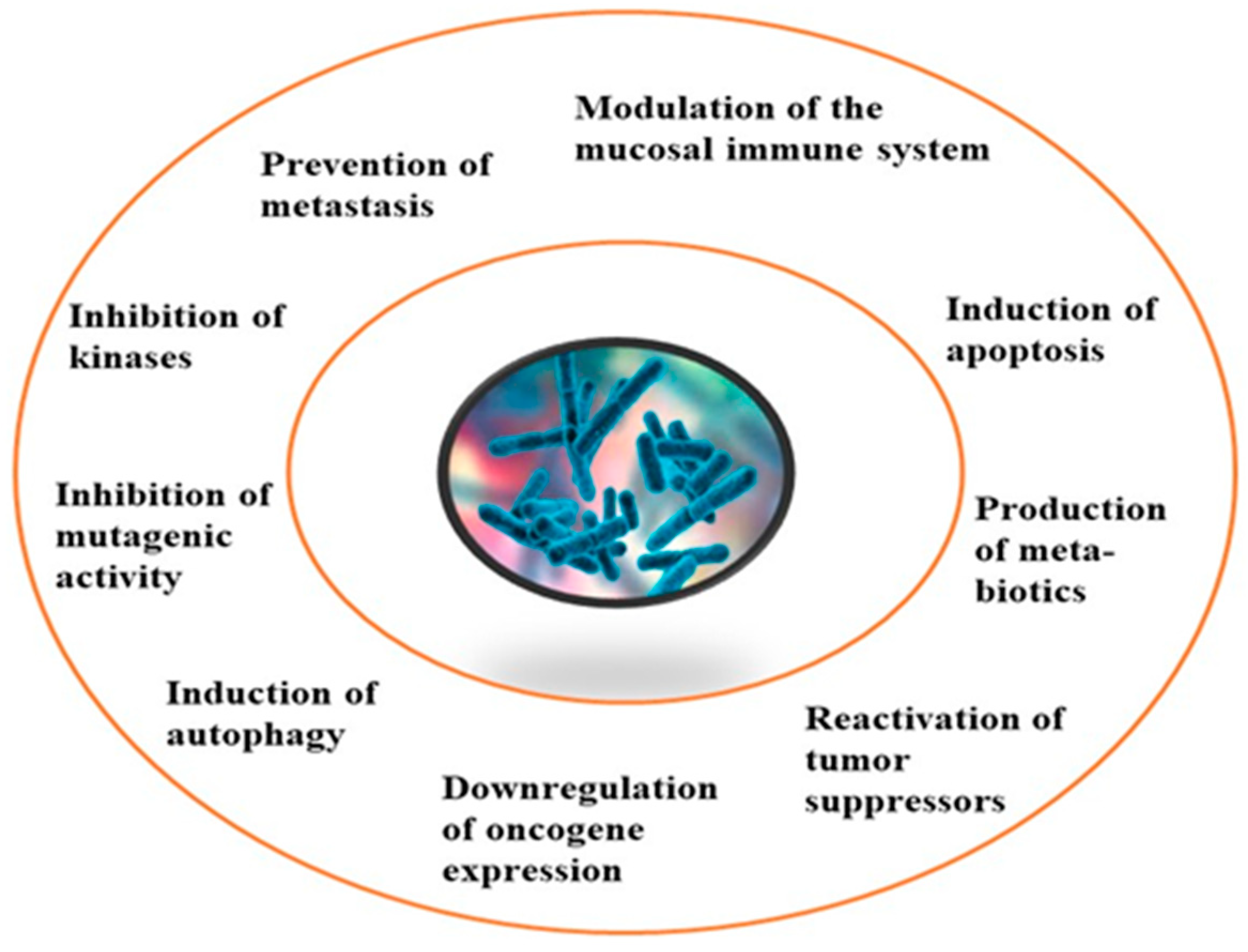


Disclaimer/Publisher’s Note: The statements, opinions and data contained in all publications are solely those of the individual author(s) and contributor(s) and not of MDPI and/or the editor(s). MDPI and/or the editor(s) disclaim responsibility for any injury to people or property resulting from any ideas, methods, instructions or products referred to in the content. |
© 2023 by the authors. Licensee MDPI, Basel, Switzerland. This article is an open access article distributed under the terms and conditions of the Creative Commons Attribution (CC BY) license (https://creativecommons.org/licenses/by/4.0/).
Share and Cite
Eze, O.C.; Berebon, D.P.; Emencheta, S.C.; Evurani, S.A.; Okorie, C.N.; Balcão, V.M.; Vila, M.M.D.C. Therapeutic Potential of Marine Probiotics: A Survey on the Anticancer and Antibacterial Effects of Pseudoalteromonas spp. Pharmaceuticals 2023, 16, 1091. https://doi.org/10.3390/ph16081091
Eze OC, Berebon DP, Emencheta SC, Evurani SA, Okorie CN, Balcão VM, Vila MMDC. Therapeutic Potential of Marine Probiotics: A Survey on the Anticancer and Antibacterial Effects of Pseudoalteromonas spp. Pharmaceuticals. 2023; 16(8):1091. https://doi.org/10.3390/ph16081091
Chicago/Turabian StyleEze, Osita C., Dinebari P. Berebon, Stephen C. Emencheta, Somtochukwu A. Evurani, Chibundo N. Okorie, Victor M. Balcão, and Marta M. D. C. Vila. 2023. "Therapeutic Potential of Marine Probiotics: A Survey on the Anticancer and Antibacterial Effects of Pseudoalteromonas spp." Pharmaceuticals 16, no. 8: 1091. https://doi.org/10.3390/ph16081091







